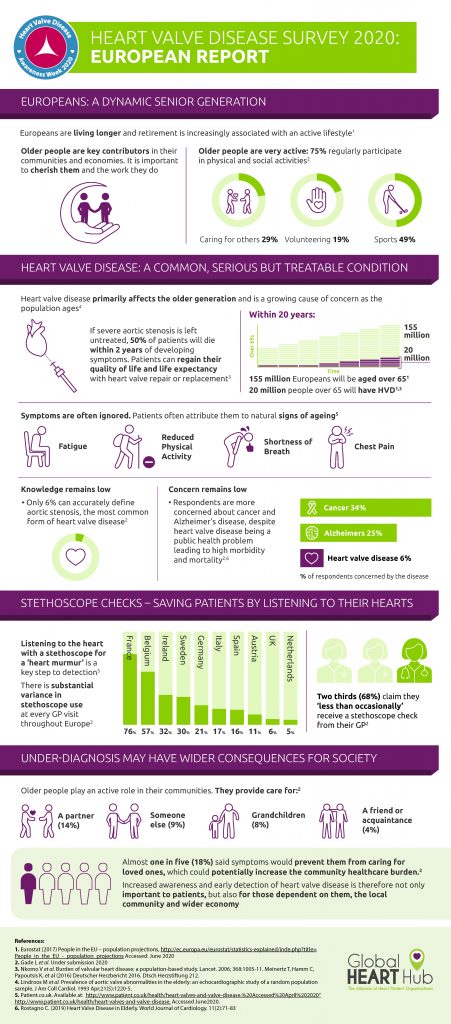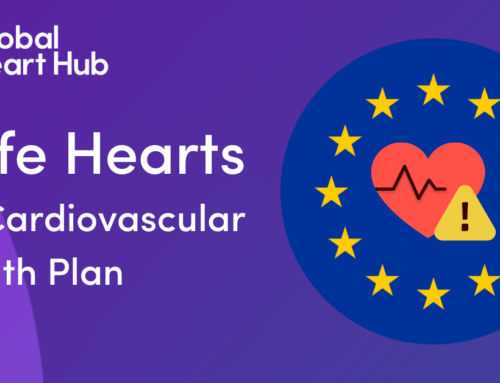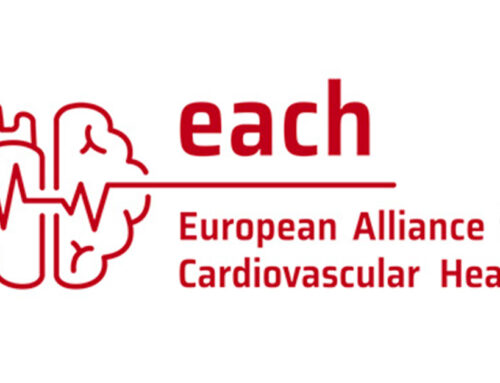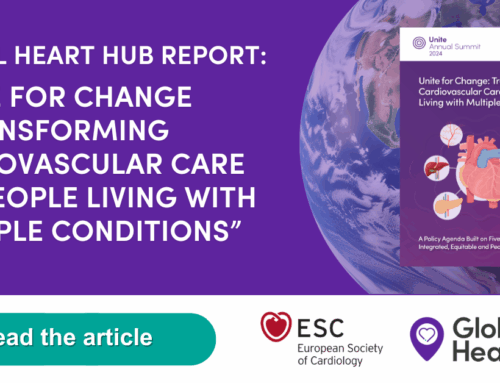Unseen army of caregivers at risk of common, serious but treatable heart disease
- Heart valve disease is a common and serious condition which is often associated with ageing, yet few older Europeans are aware of its most common form (5.6%)1
- Usually the first indication of a problem with the heart valves is a characteristic heart ‘murmur’ which can be heard using a stethoscope, but only 28% older Europeans receive stethoscope checks at every GP visit1
- More older Europeans are caregivers (Europe 29.2%); heart valve disease does not only impact individual quality of life but could also have a knock-on effect on the community healthcare burden1
Galway – 14 September 2020 – Survey results published to mark Heart Valve Disease Awareness Week show that older Europeans are as unaware as ever of the risks of common, serious, but treatable heart valve disease. Data from the latest European Heart Health Survey show that only a quarter of older Europeans would visit their doctor for investigation of symptoms, including fatigue and reduced physical activity.1 In its most serious form, more than half of patients with severe heart valve disease die within two years of developing symptoms.2
“The Survey demonstrates clearly that our older population is a key, yet underestimated, contributor to the effective functioning of our communities, families and economies, so improving the awareness, diagnosis and treatment of heart valve disease will benefit us all,” commented Wil Woan, Chair of the Heart Valve Disease Patient Council of the Global Heart Hub. “Our senior people selflessly confined themselves to protect the health of others during COVID-19; now it is time to repay them by ensuring that they receive the treatments that will transform their quality of life and lower their vulnerability to future pandemics and other significant infections.”
Senior people are crucial contributors to the economy and society.3 The Survey reveals that a third (29.2%) provide care for someone close to them.1 They are also an active group, 75% of whom regularly participate in voluntary, community-based, social or physical activities.1 Increased awareness and early detection of heart valve disease is therefore not only important to patients, but also for those dependent on them, the local community and the wider economy.
“The senior population is a group at risk, more so as they grow older, so it is important that they are more aware of the disease and understand the severity of often hidden symptoms to help ensure early diagnosis and timely treatment. It is estimated by the age of 75, the prevalence of heart valve disease is 13%4,” said Professor Helge Möllmann, lead clinician on the Survey. “More work needs to be done to shift the awareness level and that is why this week, Heart Valve Disease Awareness Week, is a key step for improved patient outcomes”.
Many people living with heart valve disease do not experience severe or noticeable symptoms, or simply put their symptoms down to ageing, which makes diagnosis of the disease challenging. This new Survey worryingly reveals how a low percentage of older Europeans would seek an appointment with their GP if they experienced key heart valve disease symptoms such as fatigue (26.2%), reduced physical activity (19.9%) and ‘feeling older than your age’ (12.5%).1 Such hesitancy could potentially be harmful, as it prevents early detection opportunities.
Initial detection of the disease involves identifying symptoms and listening to the heart with a stethoscope. Across Europe there is substantial variance in stethoscope use on older people at every GP visit, ranging from 76% in France to 5% in the Netherlands.1
“The Global Heart Hub patient groups are united in communicating a powerful message during Heart Valve Disease Awareness Week,” commented Neil Johnson, CEO of Irish heart and stroke charity, Croí and Director of Strategy and Development for the Global Heart Hub. “As the Survey results demonstrate, we need to cherish our older generation because of the essential contribution they make to our economies, communities and families. That starts with a regular stethoscope check for heart valve disease and culminates in effective treatment that gets them back to an active life.”
Heart valve disease is the name given to any malfunction or abnormality of one or more of the heart’s four valves, affecting the flow of blood through the heart. It is a common, serious, but treatable condition which is particularly associated with ageing. If diagnosed in a timely way, patients can return to a good quality of life, therefore early diagnosis is essential.5 The condition is usually caused by disease, wear or damage to the heart valve or valves.6 Key symptoms include chest tightness/pain, abnormal heart beats and shortness of breath.7
References:
[1] Gaede. L et al. Under Submission, 2020
[2] Otto CM. Timing of aortic valve surgery. Heart 2000; 84:211–218
[3] Global Coalition on Aging. Healthy heart for healthy aging: the need for awareness, innovation, and collaboration in Cardiovascular Health. White Paper. 2020.
[4] Nkomo V et al. Burden of valvular heart disease: a population-based study. Lancet. 2006;368:1005-11
[5] Heart Valve Voice. Available at https://www.heartvalvevoice.com/heart-valve-disease/treatment Accessed April 2020
[6] British Heart Foundation: Heart Valve Disease. Available at: https://www.bhf.org.uk/heart-health/conditions/heart-valve-disease. Accessed July 2020
[7] Patient.co.uk. Available at: http://www.patient.co.uk/health/heart-valves-and-valve-disease. Accessed April 2020.







